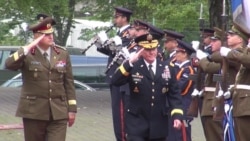The cheers for Russia in Ukraine’s annexed Crimea peninsula were, for many Estonians, an eerie reminder of their past.
“It is history repeating itself, because in 1940 when Estonia was occupied by the Soviet Union, it was basically the same scenario,” Estonian Army 2nd Lieutenant Simmo Sarr said.
Back then, a Russian coup d’état was made to look like a popular revolt. Unfair elections followed, which put the Communist party in charge of the Estonian government. The new Communist leaders quickly asked to join the Soviet Union, and a new member of the Union of Soviet Socialist Republics - the U.S.S.R. - was born.
Today, NATO member Estonia has a proud alliance, led by the United States, that has pledged to defend its sovereignty. The US has had about 5,000 service members rotate in and out of Estonia since Operation Atlantic Resolve, an effort to reassure allies in eastern Europe, started up last year, according to a U.S. official.
“There’s no greater symbol of commitment than the presence of U.S. soldiers, men and women, America’s sons and daughters on the ground. And they’re here.” U.S. General Martin Dempsey, the Chairman of the Joint Chiefs of Staff told VOA during a visit to Estonia Tuesday.
The United States’ top general met with the Estonia’s leaders in the capital, Tallinn, including the president, the prime minister and the Estonian chief of defense.
“We are very happy having the US jet planes and A-10s flying in Estonian skies, giving the security feeling,” said Estonian Defense Chief Riho Terras, “which in this turbulent times is needed, not only for the armed forces but mainly for our people.”
“Fine Line”
The increased presence is the Obama administration’s attempt at “trying to walk a fine line,” according to Brooking’s Institution scholar Michael O’Hanlon.
“Not being provocative…but making it very clear that if [Russia] were to cross over, this would mean war with the United States,” he said.
However, it would be a war that, according to O’Hanlon, the United States lacks the defense fortifications and rapid response ability in Europe to “literally prevent.”
Russia is “so close,” he says, that instead of preventing attacks in NATO’s east, the US would have to react to the first Russian blow.
Even the head of the United States European Command, Gen. Phil Breedlove, admits that Russia’s “close proximity” to Eastern European nations gives it “great flexibility." However, he disagrees with O’Hanlon’s assessment.
“I think we are able to meet the threat,” Gen. Breedlove told VOA.










